500 North Broadway Less Prison-Like
In a July 2010 post I described 500 North Broadway as a “prison-like office building.” The building was sold in January 2011, the new owners intent to change its image:
Robert Guller, principal of BEB Management of Town and Country, said Friday that he will invest $10 million to $15 million on improvements to 500 North Broadway over the next year or so. He also plans to sell the naming rights of the 40-year-old building.
Guller and his father, Arthur, completed their cash purchase of the building on Wednesday. (stltoday)
Two and a half years later the building remains heavy& dark, but the new entry/lobby is very welcoming, especially at night.
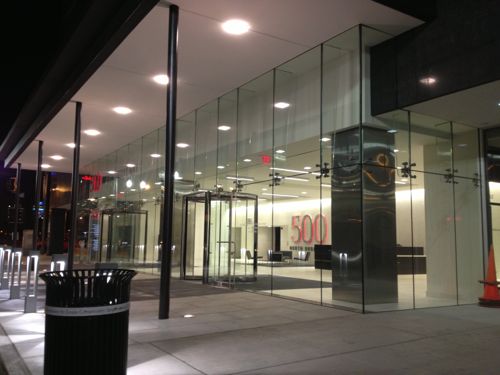
We should go back to see what it used to look like to appreciate the changes.
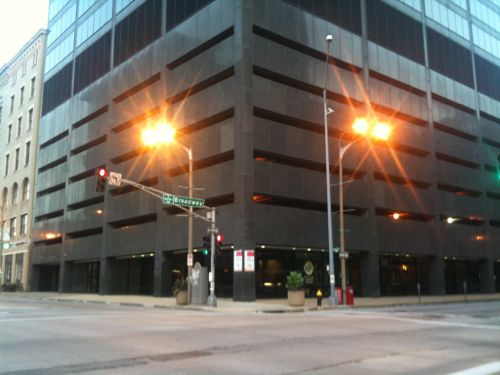
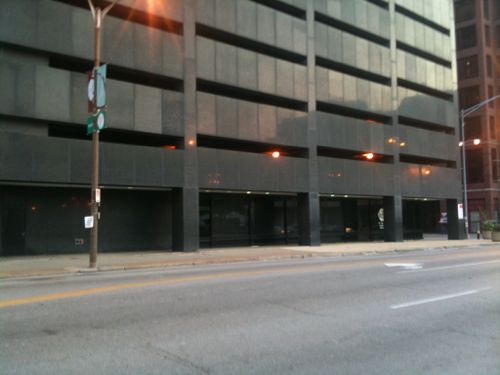
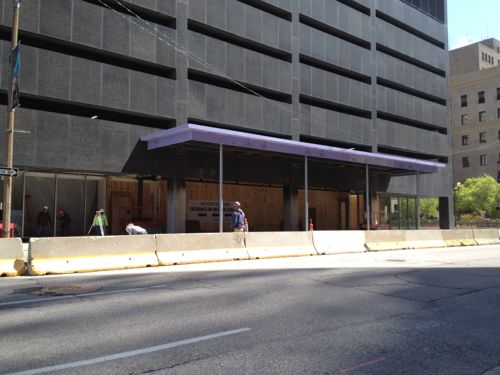
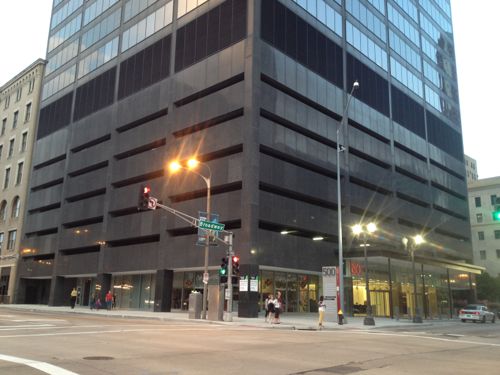
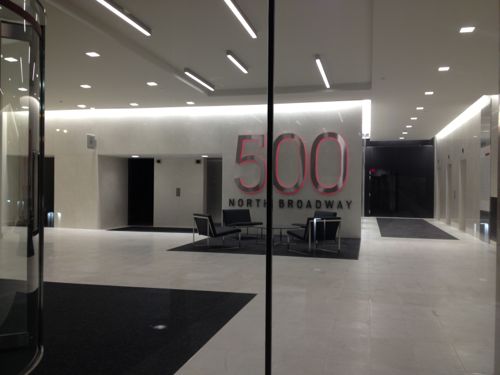
When the building was sold in 2011 it was mostly vacant, still is based on the tenant list out front. Now that construction is complete there will be tenants interested in relocating to this location. Other buildings, like One Financial across Broadway, are also getting new lobbies to shed tired old looks so they can retain/attract tenants.
Kuddos to the owners & architects for improving the outward appearance of this building.
— Steve Patterson
Agree, the new lobby is a big improvement – hopefully new tenants will now follow. Do you know who did the design? They deserve some recognition. Disagree on both the characterization as “prison like”, both then and now, and that “five levels of parking on top of the ground floor kill the appearance.” In high-rise office structures, like this one, what one experiences as a pedestrian, at street level, has little to do with what is happening on the upper floors – it doesn’t matter if the floor houses parking, a cube farm, a conference center or executive offices, the outside will not be animated, and the horizontal bands of glazing or louvers will be boring. And no, changing to traditionally-detailed brick punctuated with double-hung windows won’t change things much – it’s still a big box looming over you as you walk down the sidewalk. Plus, in this case, dedicating the first six floors to non-office uses makes sense, since the lower floors are typically the hardest ones to lease and the ones generating the lowest rental rates – something about no views and little sunlight.
Pedestrians relate to more than the ground floor of a building, up to about 3-5 floors. Windows are more inviting than dark stone.
Amen, Steve, I’ve noticed that even parking garages that have ground floor retail but are just ugly above still don’t give me a sense of place or visual enjoyment.
Actually, other than to satisfy a few urbanists around town, no practical, rational, reasonable or otherwise construction-savy individual would petition for retail space on the ground floor of a parking garage. Those with a personal agenda might. But they’re still not practical, reasonable, rational or (certainly) construction savy. It’s as foolish as placing a luxury apartment over a porta-potty and bitching about the odor.
First, I’ve always considered the building to be adequate. It did (does) what it’s supposed to do without lots of fanfare. Material selections appear to be practical, since the building has held its own over the years without any signs of rust or oxidation. And now I’ve studied both photos, before and after. Other than adding a few very visible lights which obviously brightened up the first level, and tacking on a canopy/vestible that, in my opinion, is neither inspired nor unimaginative, the building now appears to be ready for another 20 or 30 years of service–without fanfare, without turning any eyes to admire to despise. It’s one of those buildings that George Kassabaum, Bob Downey, Ted Wofford and Andy Trivers would walk past and sense no real reason to look up other than to avoid walking into a column. And that’s OK.
These improvements help this intersection immensely. I could never figure out why they basically blacked out the windows on the lower level. It felt devoid of life and empty when you walked past it even though there was a little shop on the ground level.
I think the improvements look great.
The new lobby lightens the street. It does what it’s suppose to do. Sure, we can go around and retro any building to make it fit what the ‘style’ should be. But why? this building adds it’s own beauty to the downtown. Just like Twain, some people’s trash is another’s treasure. As long as it’s full of tenants, we’re good.
Or I could critique about the stark nakedness of the lobby and it’s lack of life. What? They couldn’t put in a coffee/news stand?
Whoever designed that new lobby and entrance did a terrific job
The new entrance is an improvement, but the building as a whole is a disaster. It along with the half mall building should be slated for demolition well ahead of historic buildings like Cupples.
Early architectural writings from Palladio to Vignola define aesthetics of columns, there is the plinth, the astragal, and the abacus, with the height of the column 7 diameters, or divide the cornice into four parts, the capital into 3 and base into 2 gives the principal horizontal divisions. (The American Vignola by Ware)
Classic architect is concerned with what the person in the street sees. The 500 Broadway building could care less. It as Aldo Rossi said in one of his essays and to paraphrase, that improvements and innovation in architecture has been taken over by the money people who have turned buildings into soulless hulks.
This building isn’t architecture, it is merely a placeholder, built by someone unconcerned about the surrounding society.
The architect is limited by the budget, which is controlled by the developer. Your post suggests that the developer might be universally mandated to direct his architect to embark on classical designs– in all cases, regardless of budget, regardless of building location, building use, building type, Owner preference? Like it or not, MONEY still talks. And until you can step up to the plate with a bag of money sufficient to fund a building project with a budget to support a classical design (as if a classical design is necessarily worthy of homage and deserving of exalted status) , I suggest you continue to stand on the the sidewalks and play the role of Sunday afternoon sidewalk superintendent. And concerning your statement about Cupples and similar buildings, why didn’t you step forward with a plan ($$$) to save this “treasure”? If you can’t put up, you probably need to put your comments and opinions in their proper perspective–which is that of a well-intentioned citizen with strong, provincial personal opinions about how things “should be”, but without the financial wherewithal to make things happen. There are lots more like you! Imagine a economic system, an educational effort, a social experiment with only one set of assumptions about how things should ‘be’. Boring and probably ineffective, eh?
Please, I’m so sick of the money meme. You obviously know very little about architecture or construction, otherwise you would know a building that actually related to human beings on the street could have been built for same money.
That was the point I was making about classical architecture and its concern for creating an attractive environment for human beings. I was not saying the building should be classical.
As far as Cupples goes, I am saying our priorities as a society are screwed up, we can’t evaluate what is important. One has to only look around at the what has happened to the City of St. Louis in recent decades to understand we are sowing the seeds of our own demise with the type of decision making that goes on.
A recent example is the McKee project on the northside, he has presented no plans, but the God McKee can do what he wants because of money according to you. This says screw the future of St. Louis and its people, for money is the highest value, thus no debate about city planning is necessary. (Even though much of the money he is using is public)
You and your attitude is a big part of the problem. You should stand on the street outside 500 Broadway celebrating its poor design while yelling money is the God I worship.
I don’t see you tearing down YOUR home in order to rebuild it with a more urban appearance. Apparently your money is sacred to you too. It’s just other people’s money which can be violated.
Another person who doesn’t care about the future of the city. I live in an old home in St. Louis, it is already urban.
Building is a community art, it impacts the community, there should be standards. But I guess you too prefer to let let’s say a Walgreens to do as it wishes, without regard to community standards.
There actually cities that have standards now, even in the US. Surprise, yes it is possible for cities to demand more from developers. Even St. Louis does this to an extent, although the results are mixed.
1) I earned a masters in engineering and have worked in a construction-related field as an engineer over 12 years; and as a laborer working for tuition over 6 years. Maybe some day I’ll gain as much construction savy and knowledge as you obviously have.
2)No, sir, I don’t agree that a building adorned with classical architectural details could have been originally constructed for the same $. Enlighten me, please. And with that facade, I can’t imagine how classical architectural details could even have been introduced, regardless of the budget? I’m not an architect, but sometimes I play one. And just where does the owner/developer fit into the equation? It’s entirely possible that he deplores classical details. Is he wrong to have that opinion?
3) Just so you know…..I know what is important regarding buildings like Cupples. Safety first! When a building has been allowed to suffer at the hands of unscrupulous developers and building owners, and in the process that particular building is no longer safely salvageable, it is time to move on….not without memories of the building, but certainly with a confidence that a family out there somewhere in the city will be eating dinner on a given night with all chairs filled.
4) Yes, according to me…..and according to the business world in general, I sense that those with deep pockets rule the world. Deep pockets with holes are useless.
5) I submit that sometimes, we forget that blond hair and a chiseled body don’t last forever, that it takes a back seat to substance and experience, and that there are lots more of us who don’t have blond hair and chiseled bodies, and the many of us who fit into that category get the work done and are largely responsible for the bulk of development/improvements that occur in society. Ideas like people must have substance. If we limit our society to those with blond hair and chiseled bodies, and if we limit our construction development to classically designed architecture, we’re not going to grow much–either as a society or as a business community.
5) One final question: are you envious of the 500 Broadway Bldg. architect, angry with him, or are you just angry at everyone who doesn’t support your view of architecture and development? A downtown filled with a a dozen or two Old Post Office building types, even with a few Old Cathedral types thrown in, would become fairly boring, wouldn’t it?
Did you even read my post? I used the classical example to illustrate how concerned they were over how the pedestrian perceived the building. Modern architecture can and does relate well to the pedestrian, this is not that building.
With Cupples warehouse I pointed out the dysfunctional process that has St. Louis priorities mixed up.
As far as I can see the region of St. Louis is basically an urban environment in shambles.
What I know is that there are cities that work with developers to get desired results. But what is important, those same cities do not allow these developers to walk over the interests and priorities of the citizens the city leaders represent.
In the end the developer is the winner if a desirable and attractive city is created by defining urban planning strategies. The citizens are also winners. This actually happens in cities, not many in the US, but some.
What gets me most is the contingent of the “money, money” people who appear any time a developer is asked to build their project in a way that supports the greater good. For instance if a route is a heavy transit route then buildings should support that idea and reality. The Walgreens on North Grand, North of the VA hospital is a good example of a non conforming use in my mind.
I am not satisfied with mediocrity, maybe you are.
By the way George Kassabaum passed away a number of years back,(his son Doug, a good architect, is around though). Bob Downey died in 2012. Neither will be walking by 500 Broadway any time soon.
@Gm…you stated that the building as a whole is a disaster. Would you be saying the same thing if it was located in, say Chicago? or New York? I would say yes. To me anyways, it’s about context. If the City had continued to prosper over the past 40 years, perhaps this would indeed blend in as it would have been leading the way. Cutting edge some might say (and probably did say back then). It just didn’t work out, and now we have in anvil in the center of the City.
Moe I think the thing about New York and even Chicago is that while this building could be located in one of those cities I perceive there is a demand for excellence on the part of citizens, the government and even the major media than takes place in these cities to a much greater extent than in St. Louis
At the end the day developers benefit by having a more vibrant, prosperous city.
For some reason the quality and appropriateness of development projects do not seem to be a concern, except here at Urban Review.
It goes back to the city government not having a vision of how all of the elements of urban life work together, to me that is the crux of the problem.
I knew all of them well. Oh, and Ted Wofford is also dead. Andy is very much alive, and i consider his vision and proven abilities on a level similar to George, Bob and Ted. I knew of Doug when he renovated SW Bank in St Louis. My father worked with him on that project. Yes, he is a “good” architect in that he is practical and doesn’t build monuments to himself. Beyond that, why would you say he is a “good architect”? I’m curious. I am not satisfied with mediocrity, but I do respect the power of those who spend the $. Like it or not, money vs vision and great insight shapes architecture. (Fountainhead) Pedestrians don’t relate to classical details any more than they relate to modern details. They look at a new building and might say, “Oh, that’s nice”. Then they finish eating their Milky Way. I’m here to tell you that the building in question hasn’t offended as many people as you might suspect. It’s just another building, sitting next to another building, which a typical pedestrian also doesn’t give much attention to. Three seconds after looking at the 500 Broadway Building, average Joe Citizen couldn’t tell you if its black or white, green or red, if it has classical detailing, or if it even has columns. He might remember where the front door is located. .Those of us in the building industry probably pay more attention to a particular building than Joe Average, but even in my case, it’s just sheet metal and glass, brick or stone, Cor Ten Steel, or exterior plaster…..and it all works. Most importantly, it works for the owner and serves customers and building patrons reasonably well. That along with the absence of any KC MO Hyatt Regency incidents…..all make for a pretty “good” building in my opinion. And there’s nothing wrong with a Walgreen’s on North Grand, or on South Grand.Both will serve customers’ needs and, hey, the “owner” can well afford to build them! And you probably can’t!
I get it, you’re okay with mediocrity.
Many will go to great lengths to defend mediocrity.
And what’s wrong with “mediocre”? Average ability and average performance is the norm. In that regard, most of society is mediocre. I’ll bet both of you (Gmichaud and SPatterson) are mediocre performers also. Based on your comments and similar somewhat narrow-minded , predictable, provincial attitudes about others’ ideas and interests, I can’t imagine that either of you is the blond-haired/chiseled body type that has stood out after having accomplished remarkable things in life. And that’s ok. Not everyone is predestined for greatness. Similarly, not every building has to represent an outstanding contribution to the world. Some can get by just by being what they are. (I grew up with Mr Rodgers). I suggest that both of you get together and pool your pennies to the end that you can develop your own building in downtown St Louis City, built right up to the sidewalk, totally without vehicle parking (not even with as much as a parking slip near the front door) (get a variance!!!!), with lots and lots of bicycle racks, a building adorned with classical embellishments (and if they don’t “fit”, hang ’em on the building anyway–just because!). Fashion the building design so that it can be rented out in 1,400 SF increments, then hang up a for-lease sign and get ready for all the potential shop owners to line up to sign leases. Forego the $15.00 SF lease rates and charge $35.00 SF because your building is “urban” and “classical”. I’m certain you’ll attract customers from all over Missouri and Illinois–and Canada–just because you offer no parking, have plenty of bike-rack space, and offer columns with ornate Corinthian styled entablature and pedestal! Then, a few months after you open, when you’re facing bankruptcy, hope like hell that there’s a “old building” next door that you can convince the City to sell you so that you can tear it down to build a precast parking garage to accommodate customers’ vehicles.
You might want to check a dictionary, mediocre is not the same as average.
Mediocrity n. 1) The quality or state of being mediocre 2) moderate ability or value
Webster’s New Collegiate Dictionary, Copyright 1981 by G&C Merriam Co, catalogued in the Library of Congress under title: Webster’s New Collegiate dictionary.
Moderate: adj. (same source): tending toward the mean or average amount or dimension
Now, what cha got?
“The most insiduous influence on the young is not violence, drugs, tobacco, drink or sexual perversion, but our pursuit of the trivial and our tolerance of the third rate.” http://www.urbandictionary.com/define.php?term=mediocrity
I really don’t know if I can agree. Seems to me that this city has been harmed more by violence, drugs, alcohol and rape and other crimes involving sex than by any pursuit of “the trivial” and by any tolerance for mediocre. Let’s raise the level to “mediocre” first, before we complain that it ain’t high enough. Now I think you should find another profound quote to throw back at me.
I agree with this Steve. The quality of life in cities, or the lack of it impacts all facets of life. It is not easy to measure, but when comparing cities like Helsinki, Finland with St. Louis, both about the same population: why are there no slums in Helsinki? For some reason our democracy does not ask these questions and many more.
The pursuit of the trivial and tolerance of the third rate is evident anywhere in St. Louis. It is a trajectory that contributes to the many ills of society as you I believe you have noted correctly.
Mediocre means poor. That is the state of city planning as reflected by this building. Actually across the street at the Stifel Nichol building is an attempt to create a more human environment. It might lead to questions about how is the intersection best configured to accommodate walking, transit, as well as auto. The other two corners in the intersection are underutilized, a broad concept of development for this important city site is worthy of discussion. Such a discussion would likely yield a building much different than 500 N. Broadway.
As far as money goes, the explanation is thus: architecture and cities are the creations of man, money is the creation of man.
Or as it says in the Bhagavad Gita “to deep seeing eyes, gold, mud and stone are one” Money is but one factor in the development of cities.
“He who try to build building with handful of mud and stone in left hand, and handful of gold in right hand….will find more success if he grab a garden hose and wash away all mud and stone from left hand and then fill both hand with more gold.” –wise and wealthy Chinese philosopher of mediocre status